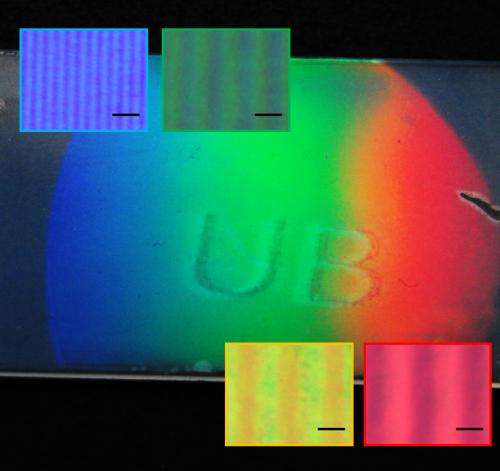In a single step, engineers create a rainbow-colored polymer

(PhysOrg.com) -- University at Buffalo engineers have developed a one-step, low-cost method to fabricate a polymer with extraordinary properties: When viewed from a single perspective, the polymer is rainbow-colored, reflecting many different wavelengths of light.
Used as a filter for light, this material could form the basis of handheld multispectral imaging devices that identify the "true color" of objects examined.
"Such portable technology could have applications in a wide range of fields, from home improvement, like matching paint colors, to biomedical imaging, including analyzing colors in medical images to detect disease," said UB Vice President for Research and Economic Development Alexander N. Cartwright, one of the UB researchers who led the study.
The ease of producing the polymer could make it feasible to develop small devices that connect with cell phones to conduct multispectral imaging, said Qiaoqiang Gan, a UB assistant professor of electrical engineering and another member of the research team.
"Our method is pretty low-cost, and because of this and the potential cell phone applications, we feel there is a huge market for improving clinical imaging in developing countries," Gan said.
Because the colors of the rainbow filter are produced as a result of the filter's surface geometry, and not by some kind of pigment, the colors won't fade over time. (It's the same principle that gives color to the wings of butterflies and feather of peacocks.)
Cartwright and Gan's team reported on their polymer fabrication technique online Feb. 22 in Advanced Materials, an academic journal. Coauthors on the study also include UB students Ke Liu and Huina Xu and UB research scientist Haifeng Hu.
The UB Office of Science, Technology Transfer and Economic Outreach (STOR) has submitted a provisional patent application detailing the production process to the U.S. Patent and Trademark Office.
To create the rainbow material, Liu and Xu sandwiched a photosensitive pre-polymer syrup between two glass slides. (A photosensitive substance is one whose physical properties change upon exposure to light.)
Next, they directed a laser beam through a curved lens placed above the pre-polymer solution. The lens divided and bent the laser beam into light of continuously varying wavelengths.
As this light hit the solution, monomers in the solution began joining into polymers, forming a continuous pattern of ridge-like polymer structures. Larger ridges rose where the light struck with more intensity.
The resulting structure is a thin filter that is rainbow-colored when viewed under white light. This is because the periodic polymer layers reflect a continuous spectrum of colors, from red on one end to indigo on the other.
The single-step fabrication method -- shining a laser light through a curved lens -- is affordable and relatively simple.
The filter the researchers created was about 25 millimeters long, but the technique they used is scalable: It's possible to create filters of different sizes by shining the laser through lenses of different sizes.
Gan said the next step for the researchers is to improve the quality of the rainbow filter. The team is also beginning to explore ideas for incorporating the technology into handheld devices.
More information:
An abstract is available here: http://bit.ly/zDK42U.
Liu presented the results of this work with the rainbow-colored polymer grating as a post-deadline paper at IEEE Photonic Annual Meeting in Arlington, Va., in October 2011.
Provided by University at Buffalo




















